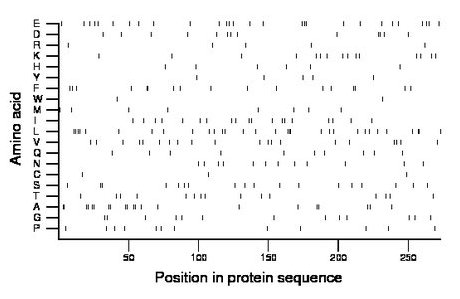
| Name: ERP27 | Sequence: fasta or formatted (273aa) | NCBI GI: 22748703 | |
|
Description: endoplasmic reticulum protein 27 kDa
|
Referenced in: Additional Protein Modifications
| ||
|
Composition:

Amino acid Percentage Count Longest homopolymer A alanine 7.7 21 2 C cysteine 1.1 3 1 D aspartate 4.8 13 2 E glutamate 10.3 28 2 F phenylalanine 6.2 17 2 G glycine 4.8 13 1 H histidine 2.2 6 1 I isoleucine 7.0 19 1 K lysine 5.5 15 1 L leucine 11.4 31 3 M methionine 2.9 8 1 N asparagine 4.4 12 1 P proline 4.4 12 1 Q glutamine 3.7 10 1 R arginine 1.8 5 1 S serine 6.6 18 2 T threonine 5.5 15 1 V valine 7.3 20 1 W tryptophan 0.7 2 1 Y tyrosine 1.8 5 1 |
Comparative genomics:
Search single species RefSeq proteins at NCBI
Search summary 
Figure data | ||
Related human proteins:Protein Relative score Description Self-match 1.000 endoplasmic reticulum protein 27 kDa P4HB 0.199 prolyl 4-hydroxylase, beta subunit precursor PDILT 0.170 protein disulfide isomerase-like, testis expressed [... PDIA2 0.152 protein disulfide isomerase A2 SHOC2 0.010 soc-2 suppressor of clear homolog CBLB 0.010 Cas-Br-M (murine) ecotropic retroviral transforming ... SIGLEC1 0.010 sialoadhesin precursor C20orf12 0.010 hypothetical protein LOC55184 LINGO2 0.008 leucine rich repeat and Ig domain containing 2 [Homo... IGF2R 0.008 insulin-like growth factor 2 receptor precursor [Ho... ULK2 0.008 unc-51-like kinase 2 ULK2 0.008 unc-51-like kinase 2 PODXL 0.006 podocalyxin-like isoform 2 precursor PODXL 0.006 podocalyxin-like isoform 1 precursor LINGO3 0.006 leucine rich repeat and Ig domain containing 3 [Hom...Human BLASTP results (used to prepare the table) | |||
Gene descriptions are from NCBI RefSeq. Search results were obtained with NCBI BLAST and RefSeq entries. When identical proteins are present, the self-match may not be listed first in BLASTP output. In such cases, the table above has been reordered to place it first.
See About the Figures for the scoring system used in the figure above right. The same scoring system was used in the table of BLASTP results.
Guide to the Human Genome
Copyright © 2010 by Stewart Scherer. All rights reserved.
